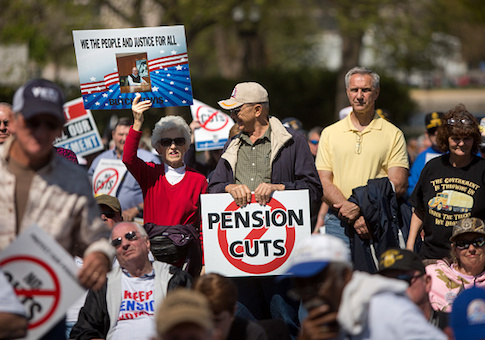A pair of lawmakers is working to overhaul pension rules to bolster struggling union retirement plans.
On Tuesday Rep. Phil Roe (R., Tenn.) and Rep. Donald Norcross (D., NJ) laid out their plan to allow companies and unions to transition multiemployer pension plans to a hybrid model combining existing defined benefit plans with 401(k)-style defined contribution plans. The bill would update rules governing traditional pension plans in which multiple employers pay into a system to sustain retirement benefits for a pool of workers not just their own employees—a popular model in the construction and shipping industry.
Norcross, a career electrician who also spent 17 years as a business agent at International Brotherhood of Electrical Workers Local 351, said Congress needs to address the issue to avoid a "national financial meltdown." There are 1,400 multiemployer plans active in the United States with more than $500 billion in assets to cover 10.4 million workers, according to the National Coordinating Committee for Multiemployer Plans. The current system puts employers solely on the hooks to pay out annualized benefits to workers, but when one company in a plan goes out of business, the remaining companies must cover those obligations. The model, Norcross said, could prove unsustainable if employers are not given another option.
"Everyday that goes by that we don't do something [risks] a financial meltdown," Norcross said. "The hybrid takes the best of both systems ... and allows plans to grow and flourish."
Under the legislation, which is called the Give Retirement Options to Workers (GROW) Act, union pension plans can create tiered systems for benefits; existing defined benefit plans would be protected and be required to maintain a 75 percent funding rate for longterm liabilities, while also creating defined contribution plans moving forward. The defined contribution plans would have to maintain 120 percent funding levels to handle stock market volatility. Companies will not be able to force union workers to join such plans without approval from the membership.
Roe called multi employer plans "critical" to retirement security for workers, but said more needed to be done to "grant stability and certainty" to employers. One of the main issues facing existing plans is that they have a hard time attracting new contributors. Employers fear that joining a struggling fund will leave them holding the bag. The hybrid option could attract companies to join existing pension plans and their contributions would help fund the legacy defined benefit systems.
"We've got to encourage more businesses to get in these plans," he said.
Carol Duncan, CEO of Oregon-based General Sheet Metal, said her industry has suffered from a lack of flexibility. Duncan's father started the business in 1972 to supply materials for his roofing company and the business now employs between 60 and 100 workers. Pension debt, however, threatens the viability of the business. Companies that withdraw from pension funds are forced to pay an exit fee—a penalty many take to avoid being the last one holding the bag. The cost of that fee "exceeds the value of the company," Duncan said. A switch to a hybrid plan would help her and her partners from accruing increased debt and to handle the fallout of a system in which there "are more retirees than actives."
"I'm forced to worry about the viability of my competitors," she said. "The GROW plan will retain [benefits] and increase the number of [contributors]."
Multiemployer plans have struggled in recent years having suffered from stock market losses and changes in industry that saw many contributors to those plans go out of business. In 2016, Teamsters Local 707 in New York and Ironworkers Local 17 in Ohio were forced to turn to the Pension Benefit Guarantee Corporation, a federal agency aimed at safeguarding retirement benefits, for relief after draining their bank accounts. Members of those unions were forced to take steep cuts to their benefits. The cases served as a preview for larger problems. The PBGC predicts it will go bankrupt by 2024 if trends continue, if not sooner; the Teamsters Central States fund is in danger of insolvency and its obligations to members exceed the agency's funding.
The proposal won the support of labor and industry groups. Brent Booker, secretary treasurer of the North American Building Trades Union (NABTU), the AFL-CIO's umbrella group for 14 different construction unions, said the legislation would be instrumental to safeguarding the viability of existing plans and ensuring "more financial stability over the long term." He pointed to Canada where the hybrid is common as an example of its viability and hailed them as "flexible enough to weather recession."
"What they [members] have earned is protected," he said. "Extensive stress tests [in Canada] shows it will work in the U.S."
Brian Turmail from the Association of General Contractors, an industry trade group, also praised the legislation, saying it would more "equally distribute risk" for both workers and employers. Marrying the interests of both groups will aid the economy as the construction industry continues to grow and it will help fill job openings by expanding benefits for a newer generation of employees.
Michael Scott, executive director of the National Coordinating Committee for Multiemployer Plans, said existing rules have hindered pension plans from becoming solvent. While the market has shifted to defined contribution plans, many traditional employers have been saddled with liabilities that prevent them from competing with newer companies. Even well-founded plans run the risk of spiraling into insolvency if companies and unions are not given the ability to shift.
"Outdated rules and regulations have (prevented) these plans from modernizing," he said. "Even plans that are healthy need the ability to make structural changes."
Roe and Norcross expect to introduce the legislation in the next few weeks, though no date has been set.
